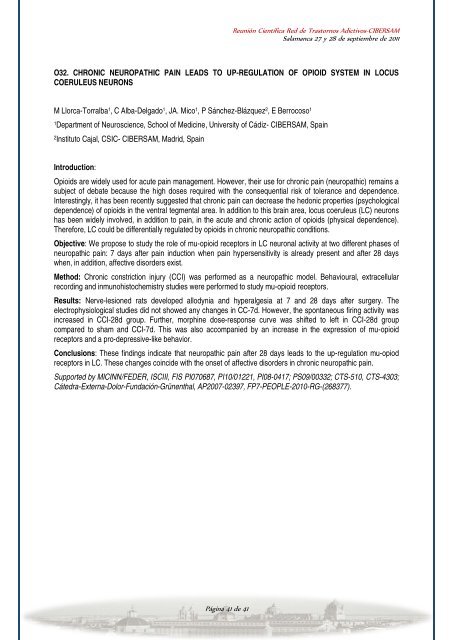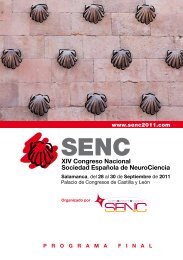Reunión Científica Red <strong>de</strong> Trastornos Adictivos-CIBERSAMSa<strong>la</strong>manca 27 y 28 <strong>de</strong> septiembre <strong>de</strong> 2011O31. Chronic treatment with the opioid antagonist naltrexone favours the coupling of spinal cord µ-opioid receptors to Gα z protein subunitsA. Díaz Martínez 1,2,4 , E.M. Valdizán Ruíz 1,2,4 , F. Pi<strong>la</strong>r-Cuél<strong>la</strong>r 1,2,4 , A. Lantero García 1,3,5 , R. Mostany Ibañez 1 , A.V.Vil<strong>la</strong>r Ramos 1,3,5 , M.L. Laor<strong>de</strong>n Carrasco 3,6 , M.A. Hurlé González 1,3,51. Universidad <strong>de</strong> Cantabria, Santan<strong>de</strong>r.2. Instituto <strong>de</strong> Biomedicina y Biotecnología <strong>de</strong> Cantabria, Santan<strong>de</strong>r3. Red <strong>de</strong> Trastornos Adictivos, Instituto <strong>de</strong> Salud Carlos III4.CIBERSAM, Instituto <strong>de</strong> Salud Carlos III5. IFIMAV, Santan<strong>de</strong>r6. Universidad <strong>de</strong> Murcia, MurciaObjectives: Opioid receptors are predominantly coupled to pertussis toxin (PTX)-sensitive, heterotrimericGα i/Gα o proteins. Sustained receptor blocka<strong>de</strong> with naltrexone is among the currently avai<strong>la</strong>ble treatments for<strong>de</strong>pen<strong>de</strong>nce disor<strong>de</strong>rs. The neurochemical adaptations produced by continued opioid antagonist treatmentsremain unclear. We investigated the changes in µ-opioid receptor signalling un<strong>de</strong>rlying pharmacologicalsupersensitivity to the effects of agonists after sustained administration of antagonists.Methods: Rats received saline or naltrexone (120 µg/h) using osmotic minipumps. On day 7, minipumps wereremoved and the analgesic response to the µ-agonist sufentanil was tested 24 hours after saline or naltrexonewithdrawal. The autoradiographic <strong>de</strong>nsity of µ-receptors, their interaction with Gα proteins (agonist-stimu<strong>la</strong>ted[ 35 S]GTPγS binding and immunoprecipitation of [ 35 S]GTPγS-<strong>la</strong>belled Gα subunits) as well as µ-opioid receptor<strong>de</strong>pen<strong>de</strong>ntinhibition of the a<strong>de</strong>nylyl cyc<strong>la</strong>se (AC) activity were <strong>de</strong>termined in spinal cord samples.Results: Chronic naltrexone withdrawal prompted antinociceptive super-sensitivity to sufentanil associated withµ-receptor up-regu<strong>la</strong>tion as well as increased DAMGO-stimu<strong>la</strong>ted [ 35 S]GTPγS binding. Concurrently, the ability ofthe opioid agonist to inhibit AC was enhanced, but the effect became resistant to PTX. Immunoprecipitation of[ 35 S]GTPγS-<strong>la</strong>belled Gα subunits confirmed that µ-receptor coupling with PTX-resistant Gα z subunits wasfavoured. The inverse agonist effect of naltrexone on cAMP accumu<strong>la</strong>tion was also enhanced.Conclusions: Following chronic naltrexone, µ-opioid receptors in the spinal cord experience a transduction shiftfrom PTX-sensitive Gα o and Gα i1-2-3 to PTX-resistant Gα z proteins. Consequently, the inhibitory effect ofDAMGO on the AC/cAMP pathway is enhanced. This transduction change is responsible for an increasedpharmacological response to agonists. Such changes in μ-receptor signalling activity could constitute animportant factor in the homeostatic dysregu<strong>la</strong>tion of the endogenous opioid system, and may possibly account forun<strong>de</strong>sirable effects in patients chronically treated with naltrexone. [Supported by: Instituto <strong>de</strong> Salud Carlos III(RTICS: RD06/001) and Ministerio <strong>de</strong> Ciencia e Innovación (SAF 2007/65451 and SAF 2007/61862)].Página 40 <strong>de</strong> 41
Reunión Científica Red <strong>de</strong> Trastornos Adictivos-CIBERSAMSa<strong>la</strong>manca 27 y 28 <strong>de</strong> septiembre <strong>de</strong> 2011O32. CHRONIC NEUROPATHIC PAIN LEADS TO UP-REGULATION OF OPIOID SYSTEM IN LOCUSCOERULEUS NEURONSM Llorca-Torralba 1 , C Alba-Delgado 1 , JA. Mico 1 , P Sánchez-Blázquez 2 , E Berrocoso 11Department of Neuroscience, School of Medicine, University of Cádiz- CIBERSAM, Spain2Instituto Cajal, CSIC- CIBERSAM, Madrid, SpainIntroduction:Opioids are wi<strong>de</strong>ly used for acute pain management. However, their use for chronic pain (neuropathic) remains asubject of <strong>de</strong>bate because the high doses required with the consequential risk of tolerance and <strong>de</strong>pen<strong>de</strong>nce.Interestingly, it has been recently suggested that chronic pain can <strong>de</strong>crease the hedonic properties (psychological<strong>de</strong>pen<strong>de</strong>nce) of opioids in the ventral tegmental area. In addition to this brain area, locus coeruleus (LC) neuronshas been wi<strong>de</strong>ly involved, in addition to pain, in the acute and chronic action of opioids (physical <strong>de</strong>pen<strong>de</strong>nce).Therefore, LC could be differentially regu<strong>la</strong>ted by opioids in chronic neuropathic conditions.Objective: We propose to study the role of mu-opioid receptors in LC neuronal activity at two different phases ofneuropathic pain: 7 days after pain induction when pain hypersensitivity is already present and after 28 dayswhen, in addition, affective disor<strong>de</strong>rs exist.Method: Chronic constriction injury (CCI) was performed as a neuropathic mo<strong>de</strong>l. Behavioural, extracellu<strong>la</strong>rrecording and inmunohistochemistry studies were performed to study mu-opioid receptors.Results: Nerve-lesioned rats <strong>de</strong>veloped allodynia and hyperalgesia at 7 and 28 days after surgery. Theelectrophysiological studies did not showed any changes in CC-7d. However, the spontaneous firing activity wasincreased in CCI-28d group. Further, morphine dose-response curve was shifted to left in CCI-28d groupcompared to sham and CCI-7d. This was also accompanied by an increase in the expression of mu-opioidreceptors and a pro-<strong>de</strong>pressive-like behavior.Conclusions: These findings indicate that neuropathic pain after 28 days leads to the up-regu<strong>la</strong>tion mu-opiodreceptors in LC. These changes coinci<strong>de</strong> with the onset of affective disor<strong>de</strong>rs in chronic neuropathic pain.Supported by MICINN/FEDER, ISCIII, FIS PI070687, PI10/01221, PI08-0417; PS09/00332; CTS-510, CTS-4303;Cátedra-Externa-Dolor-Fundación-Grünenthal, AP2007-02397, FP7-PEOPLE-2010-RG-(268377).Página 41 <strong>de</strong> 41




